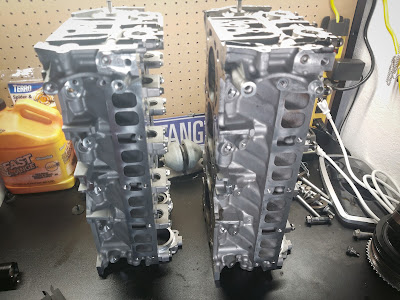The Ford 2.3L four cylinder turbocharged ecoboost engine has been around for a while now. First debuting in the 2015 Ford Mustang, the small & mighty four banger Ford has been a very popular choice for Mustang buyers.
Despite it's rough start and lack of initial interest, ecoboost sales began to take off, as the S550 Generation Ford Mustang continued to evolve.
Over the past 8 years of production, Ford only made two variants of the 2.3L ecoboost engine. There is the standard run of the mill 2.3L that you will find in the Mustang, Ranger, and Explorer. Then there is the more special and rarer version that first came in the 2016 Ford Focus RS, then later in the 2020 HPP ecoboost Mustang.Since the arrival of the RS 2.3L, many have wondered what exactly makes it better than the standard 2.3L ecoboost. What we do know is that the RS block and cylinder head is casted of a different (stronger) alloy, and it's fitted with different pistons, camshafts, and a larger turbocharger.
However, some have speculated that the RS cylinder head flows better than the standard 2.3L head. While that definitely seems plausible, my data shows that it's nothing more than a misguided myth.
The Comparison
I have compared both RS & non-RS 2.3L cylinder heads to see if I can find any differences that would allude to the better flow speculation of the RS head.
Here you can see both cylinder heads side by side. At first glance they may seem different, that's only because one is new and the other is used.
 |
| Left (Non-RS) Right (RS) |
When we take a closer look at them, we start to see more similarities.
Many More Similarities!
 |
| Left (Non-RS) Right (RS) |
Taking Measurements
I decided to measure the ports with a micrometer to check the size, measuring both intake & exhaust ports.The standard 2.3L intake ports measures at 33.5mm x 25mm.
The RS Intake ports also measure at 33.5 x 25mm.
Both cylinder heads have the same size intake ports, which also holds true in other areas of the head.
The exhaust ports on both heads also measure at the same size. The biggest port measuring at 49.5mm x 23.5mm, and the smaller port measuring at 46.5mm x 27mm.
Maybe the valves themselves are different sizes?
Let's find out!
 |
| Left (Non-RS) Right (RS) |
Once again, I measured the Intake & Exhaust Valve diameter on both cylinder heads using the same micrometer.
 |
| (Non-RS) |
The standard 2.3L intake valves are 32.2mm in diameter, and the exhaust valves are 30mm in diameter.
As you can guess by now, the RS 2.3L intake & exhaust valves are the same size at 32.2mm & 30mm in diameter.
 |
| (RS) |
I went through both heads as thoroughly as possible, trying my very best to identify any differences between the two.
I even decided to weigh both heads to see if there was any evidence of one having more material than the other.
And guess what?
 |
THEY WEIGH THE SAME!!!
 |
| Left (Non-RS) Right (RS) |





Comments
Post a Comment
Join the discussion!